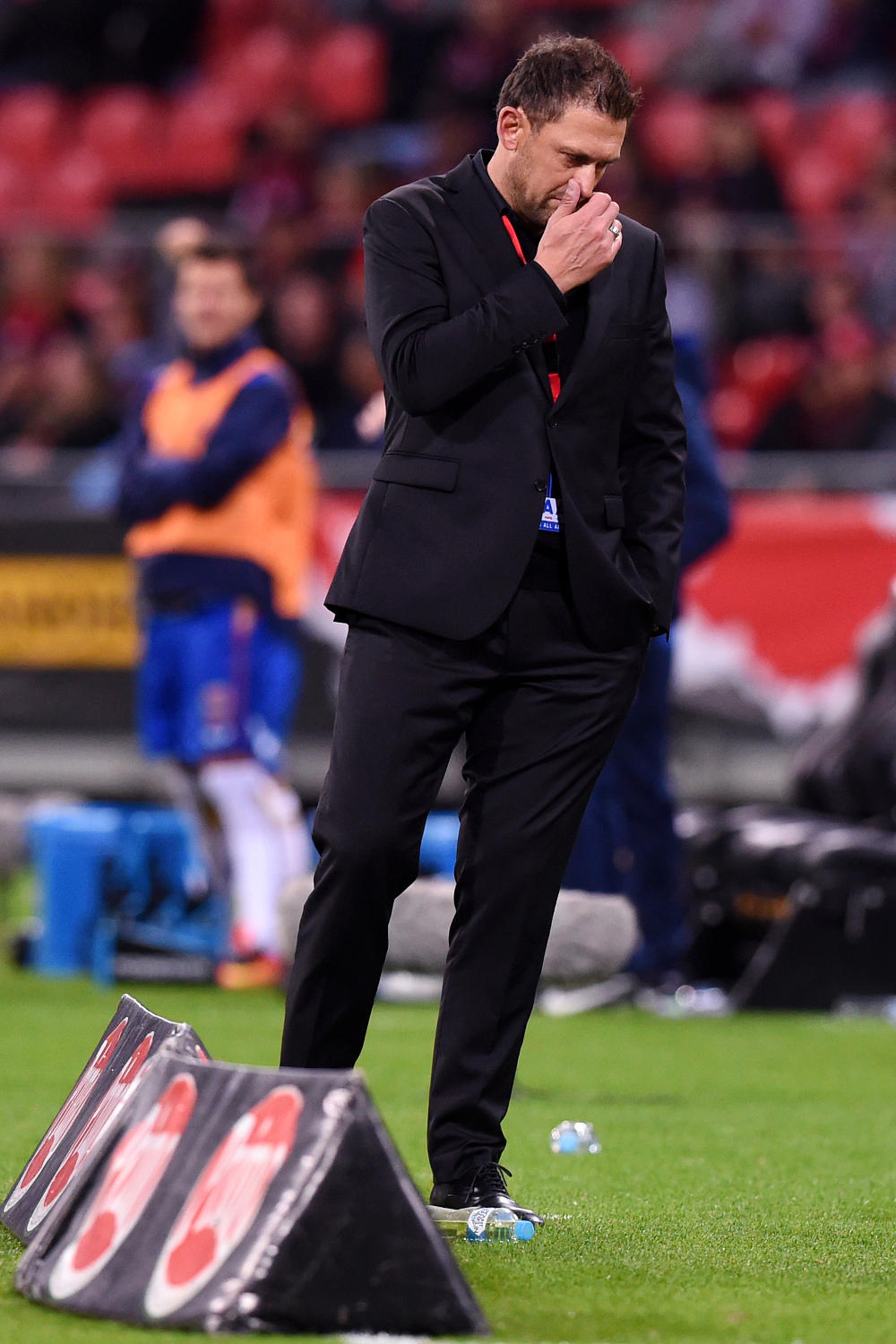A horror night, where the two A-League participants in the ACL conceded a combined 11 goals and scored one, was uncomfortable in so many ways.
There was a eeriness to the occasion, as the Roar shook hands with the Ulsan players – including former Brisbane man Dimi Petratos – in front of a starkly bare stadium as the temperature dropped sluggishly toward near-freezing.
Brisbane have done so well to make it this far, beating a Shanghai Shenhua team containing Carlos Tevez in the qualifying round a few weeks ago.
That match was evidence of how an A-League team in full, mid-season flight, can surprise an opponent yet to exit the pre-season. Tevez and company, heavy favourites on paper, were run off the park by a vivacious Roar surge, that began early through Brandon Borrello’s goal, and was sustained throughout the match.
Here though, against an Ulsan team that was not struggling to accommodate and integrate an international superstar signing, Brisbane’s match-readiness curdled horribly into instant fatigue, as the Roar’s ninth fixture in the last month descended into a hollow drubbing, the Korean team dismantling John Aloisi’s puffing bunch 6-0.
The highest profile arrival at Ulsan, in preparation for the 2017 K-League campaign, is the 22-year-old Croatian Mislav Orcic, who was superb, scoring his team’s second and third goals, going about his business with an amused expression, as every sprint he made exposed, almost comically, how laboured his markers were.
There was a gaggle of home supporters in the Munsu Football Stadium, whose drumming filled the yawning silences, the relentless pounding reverberating through the huge stretches of unoccupied grandstand.
The grating, tinny PA that announced the goal-scorers after each netted blow, thrown shrilly into action three times in the first half alone, would have felt appropriate in some dystopian future, where gaudy show-games, football matches scripted and orchestrated to inflict harrowing thrashings, were played out as a sort of state-sanctioned public humiliation.
This was humiliating for Aloisi, as Ulsan scythed through his team with deadly ease.

When it comes to most of the ACL opponents they face from Korea, Japan, China, and the Middle East, it goes without saying A-League clubs can’t compete financially. The scheduling disparity, between our season and theirs, also sets Australian teams apart, though it can occasionally be contorted to their advantage.
The fact that the A-League teams that qualify for the continental competition often change wildly every season means clubs don’t get the opportunity to acclimatise, season-on-season, to the extra fixtures, the differing conditions, the yearly obligation to represent the league in Asia.
Mark Bosnich scolded the Roar at halftime, saying they were soiling the responsibility of representing the A-League brand on the big stage. He also said, albeit as part of an extended, heated spiel, that some of the Brisbane players looked like they didn’t even want to be out there on the pitch.
It could easily be argued that – the thrill of beating Shanghai aside – Brisbane as a club don’t stand to gain much from being in the ACL at all. They won’t draw extra crowds – in fact they have moved to save money by closing parts of Suncorp Stadium for their upcoming home ACL matches – and when they beat Filipino Side Global FC in January, they lost a reported $70,000, with just 3600 fans dawdling into a fully operating stadium.
The travel saps at the squad energy, with the regular season slogging its way toward the necessary second wind of the finals series. That they often will either face hugely inferior or vastly superior opposition means that ACL fixtures approach as either an impending stroll, or a looming ordeal.
When the club makes it clear, even in implication, that the competition is viewed more as a chore than a reward, why wouldn’t that sentiment trickle down onto the pitch?
The second half did not improve for Brisbane, as Petratos set up a fourth goal within ten minutes of the restart. Andy Harper, on match call duty, was reduced to suggesting 18-year-old Roar left-back Kye Rowles ought to put in a deliberately violent tackle on his man, touching him up a little, as if that might somehow even up the fact that he’d been torched all evening.
Yes, that would have been a wonderful advertisement for the A-League in Asia; we might get thrashed to nil, but at least we’re thuggish when we’re losing.
Jade North was nutmegged by Kim In-Sung, callously removed from the equation by the Ulsan winger before he spanked home a fifth goal. By that point, Orcic had already been substituted, kept fresh for the K-League opener against Pohang Steelers on the fourth of March. Is that what this was, then? A pre-season friendly for Ulsan?
Mark Rudan called it “the darkest day” for the A-League in Asia. Aloisi pleaded with the FFA after the defeat, calling for a rescheduling of the fixtures around teams’ ACL commitments.
“The scheduling’s caught up on us. I’m sure that the FFA will look into it and make sure this doesn’t happen in the future. It’s only hurting the A-League and it hurt us definitely (against Ulsan),” Aloisi said, ashen faced and embarrassed.
There are so many reasons why this particular defeat was as brutal as it was, but an explanation of the more general ill-fit of A-League clubs in the ACL spreads out even wider than that. When Western Sydney triumphed in 2014, theirs was a journey laced liberally with good luck, and garnished with a steely resolve.
It was the culmination of a sensational first few years of existence, but since then inconsistency, in both personnel and success, has been the more common hallmark of the Wanderers.

Asian football, it could be argued, has also evolved considerably since then. In 2014, when the Wanderers beat Guangzhou Evergrande in the ACL quarter-finals, the Chinese club’s star imports were ageing Italians Alessandro Diamanti and Alberto Gilardino; the current Evergrande squad features former Spurs midfielder Paulinho and former Atleti attacker Jackson Martinez. The jump up in calibre of the kind of player the CSL is looking to import has been marked in the last year or two.
While the A-League is making steady progress, it pales in comparison to the leaps and bounds made possible by the money flushed into Chinese football, and it still lags generally behind the state of the Korean and Japanese leagues. All of this becomes even more awkwardly clear when our ‘best’ representatives are so savagely pantsed in Asia, as Adelaide, Western Sydney, and Brisbane have all been over the last two weeks.
The solution involves more than just kinder scheduling, extends beyond just an injection of more money. Rudan and Bosnich jumped from the salary cap, to transfer fees, to relegation, to youth development in their scathing post-match autopsy.
It is not an easy problem to tackle. But the longer it goes unaddressed, the less comfortable our clubs will be competing against our continental rivals.































































































